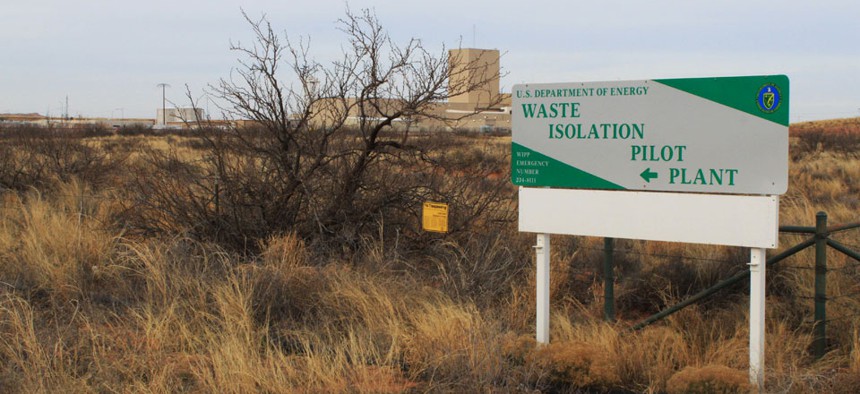Partial Probe Shows No Radiation at New Mexico Nuclear Waste Site

Susan Montoya Bryan/AP
Test did not sample source of last month’s leaks.
The Energy Department found “no detectable radioactive contamination” in a preliminary test this weekend of the country’s only underground nuclear waste storage site, which experienced a leak on Feb. 14 following a fire on Feb. 5.
But the probe did not include the locations most likely to contain radioactive leakage, according to a joint news release from Energy’s Carlsbad, N.M., Field Office and Nuclear Waste Partnership LLC, which operates the waste site.
“These results were expected because the shafts that were sampled were not in the air flow path coming from the area where the radiation release originated,” the release said.
The Waste Isolation Pilot Plant, located 26 miles southeast of Carlsbad, stores plutonium-contaminated waste in 16 miles of salt caverns mined 2,150 feet below the surface. The joint release said “radiological and air quality instruments were lowered down the salt handling and the air intake shafts, to check for airborne radioactivity and to determine air quality. The preliminary findings indicate no detectable radioactive contamination in the air or on the equipment lowered and returned to the surface. Air quality results were also normal.”
Personnel may be sent as soon as the end of this week to check the stability of the site and attempt to identify the source of the radioactive leak, the joint release said.
The underground site may still contain radioactive leakage, according to Don Hancock, director of the Nuclear Waste Safety Program at the Southwest Research and Information Center, a nuclear watchdog group in Albuquerque.
“Unless the ventilation system had totally failed, there should be no radiation detected where the probes were lowered (which is why DoE, correctly, chose those two shafts to send probes). Those are air intake shafts bringing in air from the outside,” he said in email comments to Nextgov.
“That does not mean that there still isn't radioactivity in the air in the underground at the point of the release, through the underground tunnels and the exhaust shaft where the air travels,” Hancock said. “In fact, below ground monitors continue to show low levels of radioactivity.
“Moreover, that 3,000 feet or so of tunnels from the presumed contamination point (room 7, panel 7) to the exhaust shaft must be assumed to have radioactivity in the salt and any equipment.”
Hancock said WIPP currently stores 3.2 million cubic feet of plutonium-contaminated waste generated during the manufacture of nuclear weapons by the Defense Department and has cost $6 billion to develop and operate since it first opened in 1999.
The Carlsbad Field Office and Nuclear Waste Partnership said the tests last weekend were the “first phase of an underground recovery process that will lead to the resumption of nuclear waste disposal operations at WIPP.”
Joe Franco, manager of the Carlsbad Field Office, described the test results as "a postive way to begin" the recovery process. "In order to get to this point, a lot of work has taken place and it involved a lot of time-consuming activities,” he said. “But the recovery process is underway,” he said. “We are receiving information that will get us to the next steps in the process.”
Tammy Reynolds, WIPP Recovery Process Manager for Nuclear Waste Partnership said the air sampling process this weekend “is critical in helping determine the proper personal protective equipment needed for our personnel entries” into the underground chambers.
Once the inspection team checks for levels of air and surface contamination between the air intake and salt handling shafts, Energy and its contractor said, the team will make its way down to the area of the repository where operations were being conducted prior to the radiological leak, isolate that source and develop a plan to remove the contamination.
As of Saturday, 17 WIPP employees showed “background” radiological contamination in fecal samples, but there has been no detectable contamination in urine samples, which indicates contamination was not inhaled into the lungs, Energy and Nuclear Waste Partnership said. “The levels of exposure are extremely low, and none of the employees is expected to experience any health effects from the exposures,” they said.
Hancock said the statement on exposure is “a very disturbing part of the release -- because it is false. Urine samples detect SOLUBLE plutonium [emphasis included]. Insoluble plutonium and americium in the lungs would not be detected by urine samples. Fecal samples would detect insoluble plutonium, some of which could remain in the lungs.”
WIPP stores nuclear waste contained in 55-, 85- and 100-gallon drums transported to the facility by truck inside beehive shaped stainless steel storage casks that can resist fires at temperatures of 1,475 degrees centigrade and immersion in 50 feet of water.
The waste stored at WIPP comes from sites in Idaho, Georgia and Los Alamos, N.M. Last week Sen. Tom Udall had a meeting with Energy Secretary Ernest Moniz at which he underscored the urgency with which we must have a plan to store waste from Los Alamos before the beginning of the fire season.
Los Alamos stores 5,600 containers of nuclear waste in dome-like structures made of fabric that “has exceeded its expected in-service life of 15-20 years,” the Energy inspector general reported last June. Forest fires in 2011 triggered an evacuation of the lab and the city of Los Alamos.
This story has been updated with detail and background.
Get the Nextgov iPhone app to keep up with government technology news
NEXT STORY: Federal 100: Ivy Estabrooke



